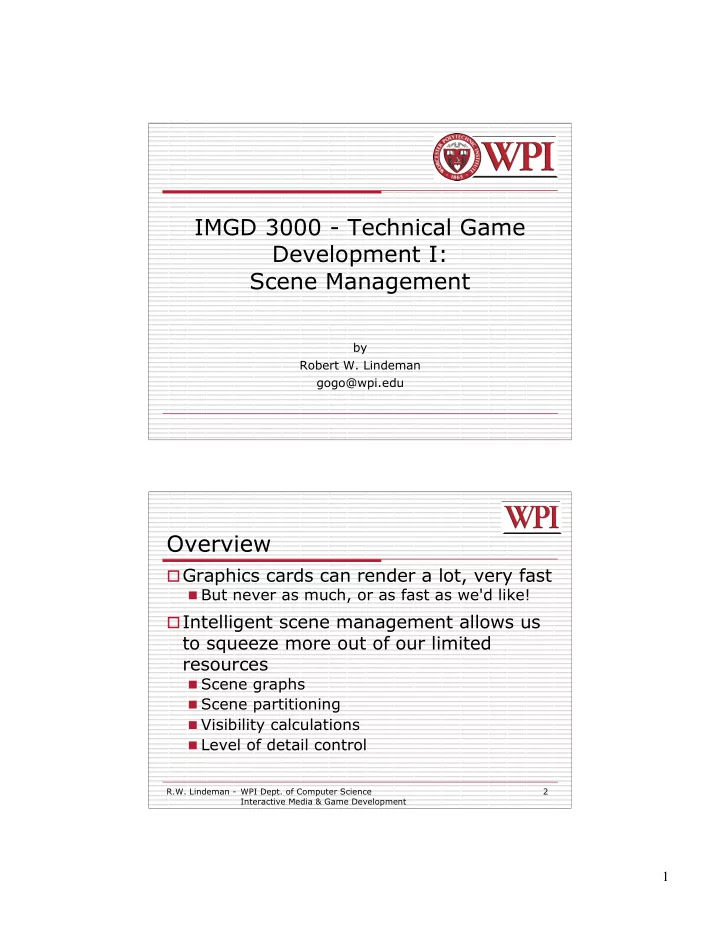

IMGD 3000 - Technical Game Development I: Scene Management by Robert W. Lindeman gogo@wpi.edu Overview Graphics cards can render a lot, very fast But never as much, or as fast as we'd like! Intelligent scene management allows us to squeeze more out of our limited resources Scene graphs Scene partitioning Visibility calculations Level of detail control R.W. Lindeman - WPI Dept. of Computer Science 2 Interactive Media & Game Development 1
Scene Graphs A specification of object and attribute relationships Spatial Hierarchical Material properties Transformations Geometry Easy to attach objects together Riding a vehicle R.W. Lindeman - WPI Dept. of Computer Science 3 Interactive Media & Game Development Scene Graphs (cont.) Can use instances to save resources Geometry handles instead of geometry Texture handles To take advantage of GPUs, reducing the amount of shader (cg) and texture switching is preferred R.W. Lindeman - WPI Dept. of Computer Science 4 Interactive Media & Game Development 2
Geometry Sorting and Culling Keys to scene management Render only what can be seen Render at a satisfactory, perceivable fidelity Pre-process what you can Use GPU as efficiently as you can First-level View-frustum culling Back-face culling Bounding sphere One or more acceleration structures can be used R.W. Lindeman - WPI Dept. of Computer Science 5 Interactive Media & Game Development Acceleration Structures Hierarchical bounding structures Test if parent is visible If not, then none of its children are If so, then recursively check the children Could use information about your application to optimize approach Many interior levels have cells and portals No need to solve the general problem, just the specific one R.W. Lindeman - WPI Dept. of Computer Science 6 Interactive Media & Game Development 3
Acceleration Structures Many structures exist Appropriateness depends on the scene, and the game (e.g., dynamic objects) Space partitioning Uniform Grid Quad/Oct Tree Binary-Space Partitioning (BSP) trees k-d trees Geometry partitioning Bounding boxes/spheres/capsules R.W. Lindeman - WPI Dept. of Computer Science 7 Interactive Media & Game Development Acceleration Structures - Space Partitioning Uniform Grids Split space up into equal sized (or an equal number of) cells Quad (Oct) Trees Recursively split space into 4 (8) equal-sized regions Binary-Space Partitioning (BSP) trees Recursively divide space along a single, arbitrary plane k -dimensional trees (k-d trees) Recursively R.W. Lindeman - WPI Dept. of Computer Science 8 Interactive Media & Game Development 4
Acceleration Structures - Object Partitioning Bounding boxes/spheres/capsules Axis-Aligned Bounding Boxes (AABB) Oriented Bounding Boxes (OBB) Discrete Oriented Polytope (DOP) Polytope: 2D = polygon, 3D = polyhedron k -DOP: k planes in a DOP Common: 6-DOP (AABB), 10-DOP, 18-DOP, 24-DOP Bounding-Volume Hierarchies (BVHs) R.W. Lindeman - WPI Dept. of Computer Science 9 Interactive Media & Game Development Cell-Portal Visibility Keep track of which cell the viewer is in Somehow enumerate all the visible regions Cell-based Preprocess to identify the potentially visible set (PVS) for each cell Point-based Compute at runtime Trend is toward point-based, but cell-based is still very common Why choose one over the other? R.W. Lindeman - WPI Dept. of Computer Science 10 Interactive Media & Game Development 5
Visibility of Cells Point-based algorithms compute visibility from a specific point Which point? How often must you compute visibility? Cell-based algorithms compute visibility from an entire cell Union of the stuff visible from each point in the cell How often must you compute visibility? Which method has a smaller potentially visible set? Which method is suitable for pre-computation? R.W. Lindeman - WPI Dept. of Computer Science 11 Interactive Media & Game Development Potentially Visible Set (PVS) PVS: The set of cells/regions/objects/polygons that can be seen from a particular cell Generally, choose to identify objects that can be seen Trade-off is memory consumption vs. accurate visibility Computed as a pre-process Have to have a strategy to manage dynamic objects Used in various ways: As the only visibility computation - render everything in the PVS for the viewer’s current cell As a first step - identify regions that are of interest for more accurate run-time algorithms R.W. Lindeman - WPI Dept. of Computer Science 12 Interactive Media & Game Development 6
Cell-to-Cell PVS Cell A is in cell B's PVS if there exists a stabbing line from a portal of B to a portal of A S tabbing line: a line segment intersecting only portals Neighbor cells are trivially in the PVS I J PVS for I contains: F B, C, E, F, H, J H D B E C G A R.W. Lindeman - WPI Dept. of Computer Science 13 Interactive Media & Game Development Eye-to-Region Example (1) View R.W. Lindeman - WPI Dept. of Computer Science 14 Interactive Media & Game Development 7
Eye-to-Region Example (2) R.W. Lindeman - WPI Dept. of Computer Science 15 Interactive Media & Game Development Putting it all Together The "best" solution will be a combination Static things Oct-tree for terrain Cells and portals for interior structures Dynamic things Quick reject using bounding spheres BVHs for objects Balance between pre-computation and run-time computation R.W. Lindeman - WPI Dept. of Computer Science 16 Interactive Media & Game Development 8
References http://www.cs.wisc.edu/graphics/Courses/679-f2003/ R.W. Lindeman - WPI Dept. of Computer Science 17 Interactive Media & Game Development 9
Recommend
More recommend